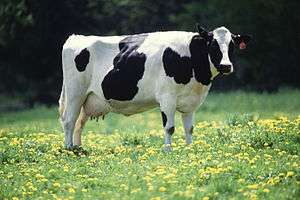Mycobacterium vaccae
| Mycobacterium vaccae | |
|---|---|
| Scientific classification | |
| Kingdom: | Bacteria |
| Phylum: | Actinobacteria |
| Order: | Actinomycetales |
| Suborder: | Corynebacterineae |
| Family: | Mycobacteriaceae |
| Genus: | Mycobacterium |
| Species: | M. vaccae |
| Binomial name | |
| Mycobacterium vaccae | |
Mycobacterium vaccae is a nonpathogenic[1] species of the Mycobacteriaceae family of bacteria that lives naturally in soil. Its name originates from the Latin word, vacca (cow), since it was first cultured from cow dung in Austria.[2] Research areas being pursued with regard to killed Mycobacterium vaccae vaccine include immunotherapy for allergic asthma, cancer, depression, leprosy,[3] psoriasis, dermatitis, eczema and tuberculosis.[3]
It has recently been hypothesized that exposure to Mycobacterium vaccae may result in an antidepressant effect, because it stimulates the generation of serotonin and norepinephrine in the brain.[4][5][6] More specifically, it induces the neurogenesis of neurons that produce those two compounds.
Other neuronal research, as of 24 May 2010, has shown that when Mycobacterium vaccae was injected into mice, it stimulated some growth of neurons. It also increased levels of serotonin and decreased levels of anxiety. "We found that mice that were fed live M. vaccae navigated the maze twice as fast and with less demonstrated anxiety behaviors as control mice", says Dorothy Matthews of The Sage Colleges in Troy, New York, who conducted the research with her colleague Susan Jenks.
M. vaccae is in the same genus as Mycobacterium tuberculosis, the bacterium which causes tuberculosis. Numerous trials have indicated that exposure to oral and injectable products derived from M. vaccae bacteria can have positive effects in treating tuberculosis. Although a 2002 review of selected clinical trials failed to find any consistent benefit of certain dosage regimens of injectable M. vaccae products in people with tuberculosis,[7] a more recent meta-analysis of 54 clinical studies of M. vaccae products for tuberculosis showed treatment resulted in improved sputum conversion and radiological (X-ray) assessment.[8]
Varying results of clinical trials with M.vaccae products may be related to different forms of the bacterium ("smooth" and "rough"). There are two main variants of Mycobacterium vaccae according to their appearance in a culture dish. One is smooth and one is rough. Immunological response in mammals to the bacterium varies greatly according to which variant is used.[9] In one study, Mycobacterium vaccae was cultured on "tryptone soy agar medium, collected, and heat killed at 121°C for 15 min."[9]
AnHui Longcom Biologic Pharmacy Co., Ltd. (Longcom) produces a Mycobacterium vaccae vaccine with the trade name "Vaccae" for the treatment of tuberculosis.[10] Immunitor Inc. has reported two successful clinical trials with its oral formulations of M. vaccae in treating all forms of tuberculosis, including drug resistant TB (MDR-TB).[11][12]
M. vaccae may serve as one biological mechanism by which historical and Ayurvedic folk remedies such as Aqua omnium florum offer their benefit.
References

- ↑ Lowry, C.A.; Hollis, J.H.; De Vries, A.; Pan, B.; Brunet, L.R.; Hunt, J.R.F.; Paton, J.F.R.; Van Kampen, E.; et al. (2007). "Identification of an immune-responsive mesolimbocortical serotonergic system: Potential role in regulation of emotional behavior". Neuroscience. 146 (2): 756–72. doi:10.1016/j.neuroscience.2007.01.067. PMC 1868963
 . PMID 17367941.
. PMID 17367941. - ↑ "Extremely drug resistant tuberculosis – is there hope for a cure?" (PDF). TB Alert – the UK's National Tuberculosis Charity. Retrieved 2007-04-02.
- 1 2 US patent 4724144, Rook, Graham A. W. & Stanford, John L., "Immuno-therapeutic composition of killed cells from mycobacterium vaccae", issued February 9, 1988
- ↑ "Getting Dirty May Lift Your Mood". Bristol University: Medical News Today. 2007-04-05.
- ↑ "Dirt exposure 'boosts happiness'". BBC News. 2007-04-01.
- ↑ "Getting Dirty May Lift Your Mood". University of Bristol News. Retrieved 2014-08-10.
- ↑ De Bruyn, Guy; Garner, Paul (2003). De Bruyn, Guy, ed. "Cochrane Database of Systematic Reviews". doi:10.1002/14651858.CD001166.
|chapter=ignored (help) - ↑
- Yang X-Y, Chen Q-F, Li Y-P, Wu S-M (2011) Mycobacterium vaccae as Adjuvant Therapy to Anti-Tuberculosis Chemotherapy in Never-Treated Tuberculosis Patients: A Meta-Analysis. PLoS ONE 6(9): e23826. doi:10.1371/journal.pone.0023826
- 1 2 Rodríguez-Güell, Elisabeth; Agustí, Gemma; Corominas, Mercè; Cardona, Pere-Joan; Casals, Isidre; Parella, Teodor; Sempere, Marco-Antonio; Luquin, Marina; Julián, Esther (2006). "The production of a new extracellular putative long-chain saturated polyester by smooth variants of Mycobacterium vaccae interferes with Th1-cytokine production". Antonie van Leeuwenhoek. 90 (1): 93–108. doi:10.1007/s10482-006-9062-1. PMID 16652204.
- ↑ AnHui Longcom Biologic Pharmacy Co., Ltd. (Longcom)
- ↑ Butov, DA; Efremenko YV; Prihoda ND; Zaitzeva SI; Yurchenko LV; Sokolenko NI; Butova TS; Stepanenko AL; Kutsyna GA; Jirathitikal V; Bourinbaiar AS. (Oct 2013). "Randomized, placebo-controlled Phase II trial of heat-killed Mycobacterium vaccae (Immodulon batch) formulated as an oral pill (V7)". Immunotherapy. 5 (10): 1047–54. doi:10.2217/imt.13.110. PMID 24088075.
- ↑ Efremenko, YV; Butov DA; Prihoda ND; Zaitzeva SI; Yurchenko LV; Sokolenko NI; Butova TS; Stepanenko AL; Kutsyna GA; Jirathitikal V; Bourinbaiar AS (June 2013). "Randomized, placebo-controlled Phase II trial of heat-killed Mycobacterium vaccae (Longcom batch) formulated as an oral pill (V7).". Hum Vaccin Immunother. 9 (9): 1852–6. doi:10.4161/hv.25280. PMID 23782489.
External links
- Bacteria and depression -- Bad is good (The Economist)
- Treatment of conditions of the central nervous system using mycobacteria - Patent 20030170275 (www.freepatentsonline.com)
- U.S. Patent 10258550 - (Google Patents)
- Compositions Derived From Mycobacterium Vaccae and Methods for Their Use (Patentscope)
- Can bacteria make you smarter?
- Google translated article from Spanish
- Type strain of Mycobacterium vaccae at BacDive - the Bacterial Diversity Metadatabase